Themed collection CO2 Separation, Capture and Reuse

CO2 separation, capture and reuse: a web themed issue
Guest editors Mohamed Eddaoudi and Len Barbour introduce this web collection celebrating current achievements and future perspectives in CO2 separation, capture and reuse.

Chem. Commun., 2015,51, 5554-5555
https://doi.org/10.1039/C5CC90085A
Chabazite and zeolite 13X for CO2 capture under high pressure and moderate temperature conditions
Mesoporous chabazite ion-exchanged with Ca2+ was effective for CO2 capture at 20 bar and 473 K, whereas 13X as a support material enabled recyclable carbonation of ca. 8 wt% Mg(OH)2 approaching the theoretical maximum for CO2 capture with 10% H2O.
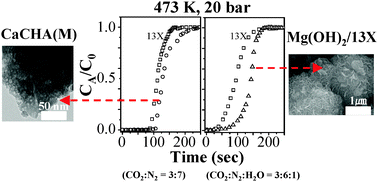
Chem. Commun., 2014,50, 4927-4930
https://doi.org/10.1039/C3CC46313C
New insights into carbon dioxide interactions with benzimidazole-linked polymers
Computational studies reveal that the excellent performance of benzimidazole-linked polymers in selective carbon dioxide capture over methane and nitrogen is facilitated by several electrostatic interactions involving the Lewis basic sites and the aryl C–H of the benzimidazole units with CO2.

Chem. Commun., 2014,50, 3571-3574
https://doi.org/10.1039/C3CC45901B
Porous organic polymers with anchored aldehydes: a new platform for post-synthetic amine functionalization en route for enhanced CO2 adsorption properties
Amine functionalization of a unique aldehyde containing porous organic polymer for CO2 capture.
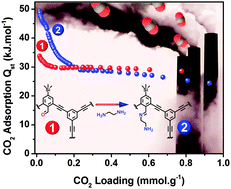
Chem. Commun., 2014,50, 1937-1940
https://doi.org/10.1039/C3CC48228F
Carbon dioxide entrapment in an organic molecular host
4-Phenoxyphenol crystallises to yield discrete ∼60 Å3 cavities capable of enclathrating CO2 molecules; gated porosity does not occur under static pressure.
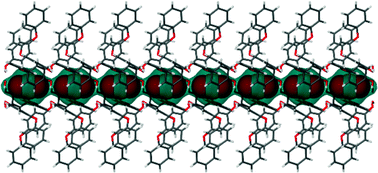
Chem. Commun., 2014,50, 85-87
https://doi.org/10.1039/C3CC46784H
Screening and evaluating aminated cationic functional moieties for potential CO2 capture applications using an anionic MOF scaffold
We demonstrate the use of an anionic MOF for the evaluation of cationic functional moieties for CO2 capture.
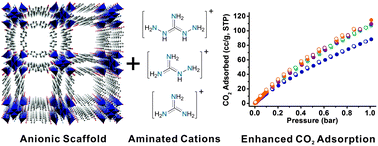
Chem. Commun., 2013,49, 11385-11387
https://doi.org/10.1039/C3CC47031H
Assembly of a unique octa-nuclear copper cluster-based metal–organic framework with highly selective CO2 adsorption over N2 and CH4
By using 4-(pyrimidin-5-yl) benzoic acid (4-PmBC) as a ligand, a porous metal–organic framework based on unique octa-nuclear copper clusters was constructed, which exhibited highly selective CO2 uptake over N2 and CH4.
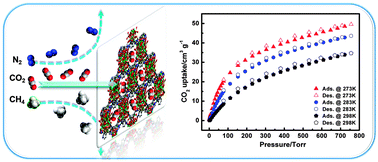
Chem. Commun., 2013,49, 11433-11435
https://doi.org/10.1039/C3CC47462C
A robust amino-functionalized titanium(IV) based MOF for improved separation of acid gases
An interdisciplinary study reveals the potential of H2S resistant amino-functionalized MIL-125(Ti) for the acid gas purification of biogas and natural gas.
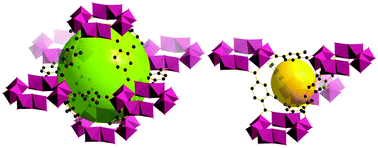
Chem. Commun., 2013,49, 10082-10084
https://doi.org/10.1039/C3CC45828H
Unprecedented activation and CO2 capture properties of an elastic single-molecule trap
The metal–organic framework PCN-200 shows an unprecedented gas-purge activation capability, which enables its use in a low-energy carbon capture process.
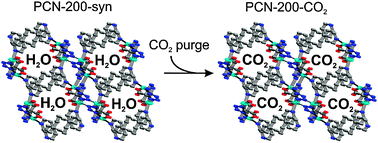
Chem. Commun., 2013,49, 9612-9614
https://doi.org/10.1039/C3CC45866K
An asymmetric tubular ceramic-carbonate dual phase membrane for high temperature CO2 separation
For the first time, a tubular asymmetric ceramic-carbonate dual phase membrane was prepared and tested for high temperature CO2 separation.
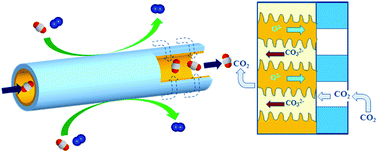
Chem. Commun., 2013,49, 9654-9656
https://doi.org/10.1039/C3CC45949G
High-pressure carbon dioxide uptake for porous organic cages: comparison of spectroscopic and manometric measurement techniques
A spectroscopic method for measuring CO2 sorption isotherms at high pressure is validated for crystalline porous organic cages.
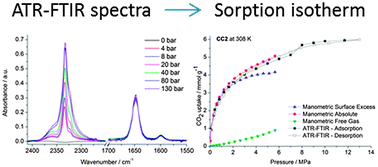
Chem. Commun., 2013,49, 9410-9412
https://doi.org/10.1039/C3CC45924A
Identification of bridged CO2 binding in a Prussian blue analogue using neutron powder diffraction
Analysis of neutron powder diffraction data for a CO2-loaded Prussian blue analogue, Fe3[Co(CN)6]2, has identified two unique bridging modes for CO2, one of which exhibits simultaneous interaction with two bare-metal sites.
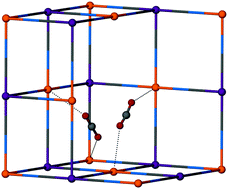
Chem. Commun., 2013,49, 9404-9406
https://doi.org/10.1039/C3CC46019C
Low-energy regeneration and high productivity in a lanthanide–hexacarboxylate framework for high-pressure CO2–CH4–H2 separation
A novel porous lanthanide–organic framework of a jjt-a topology has been realized for high pressure CO2–CH4–H2 separation with high productivities and low regeneration costs at room temperature.
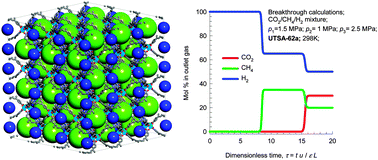
Chem. Commun., 2013,49, 6773-6775
https://doi.org/10.1039/C3CC43196G
About this collection
The scope of this themed collection is broad and covers aspects such as simulation, materials development and implementation. It will showcase the latest developments towards addressing the CO2 challenge by gathering in one themed issue contributions from talented and innovative researchers. The issue is guest edited by Mohamed Eddaoudi and Len Barbour. New articles will be added to this collection as they are published.